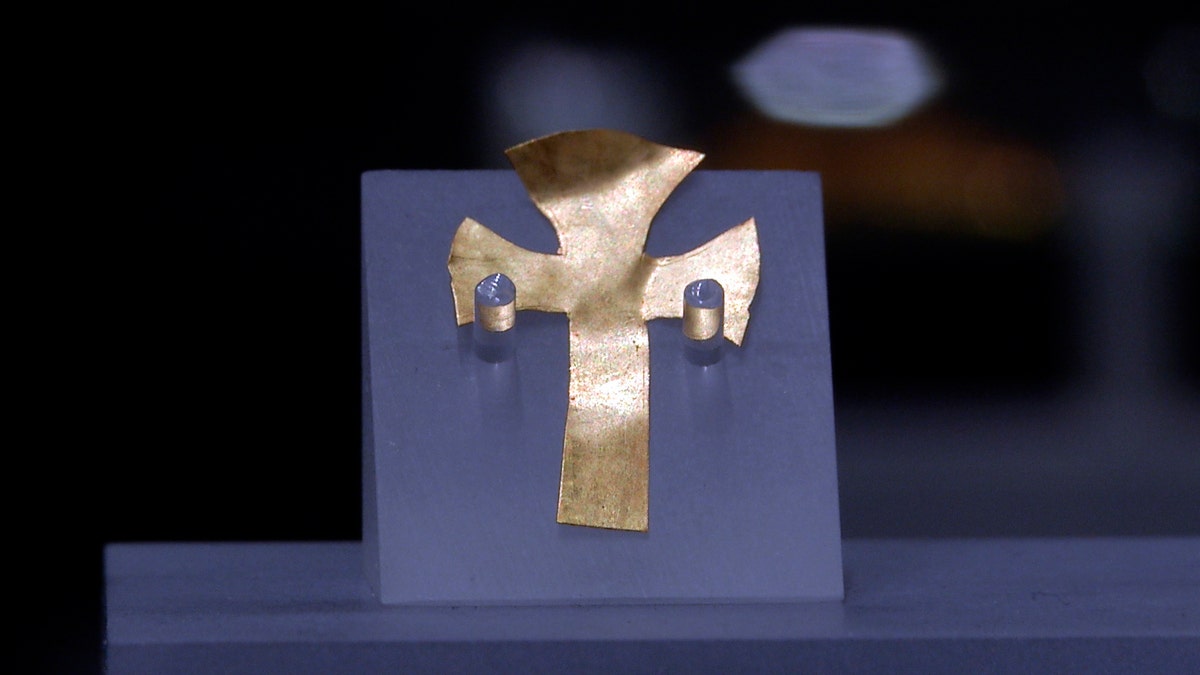Fox News Flash top headlines for May 10
Fox News Flash top headlines for May 10 are here. Check out what's clicking on Foxnews.com
Archaeologists in the U.K. have revealed new details of the earliest Christian royal burial ever found in Britain, which they compared to the famous King Tutankhamun's tomb.
In 2003, road workers in the village of Prittlewell in southern England accidentally uncovered the 1,400-year-old Anglo-Saxon tomb, which was then excavated by archaeologists. “They discovered an astonishingly well-preserved burial chamber adorned with rare and precious objects; however, many of the burial chamber’s secrets lay concealed beneath centuries of earth and corrosion and have only been revealed now,” explained in a statement the Museum of London Archaeology (MOLA), which led the research.
The discoveries include a gold buckle, which indicates a high-status burial, possibly a prince. Two small gold-foil crosses found at the head of the coffin suggest a Christian burial. “The position of the two gold coins suggests that he may have held one in each hand,” explains MOLA.
'HUMAN SACRIFICE' VICTIMS DISCOVERED AT GRUESOME ANCIENT SITE
Other finds include a 1,400-year-old painted box, which is described as the only surviving example of early Anglo-Saxon painted woodwork, and the remains of a long-lost lyre, an ancient musical instrument. “This is the first time the complete form of an Anglo-Saxon lyre has been recorded,” explained MOLA. “The wooden lyre had almost entirely decayed save for a soil stain within which fragments of wood and metal fittings were preserved in their original positions.”

An artist's impression of the burial site. (MOLA)
Intriguingly, two of the fittings in the lyre are almandines, minerals that are likely from the Indian sub-continent or Sri Lanka, according to experts. At some point in its life, the lyre had also been broken in two and put back together using iron, gilded copper alloy repair fittings, according to experts
Gleaming glassware and an elaborate water vessel from the eastern Mediterranean, perhaps Syria, have also been excavated from the site.
MISSING PIECE OF STONEHENGE RETURNED 60 YEARS AFTER IT WAS REMOVED DURING EXCAVATION
"This is a really rich burial. It's a statement, it's a theatrical statement being made about the family, about this person,” said Liz Barham, a senior conservator at Museum of London Archaeology who worked on the dig.

A gold foil cross uncovered at an Anglo-Saxon burial site in the village of Prittlewell in 2003 on display at Southend Central Museum in Southend, England, on May 8, 2019. (AP Photo/James Brooks)
Sophie Jackson, director of research and engagement at Museum of London Archaeology, said the discovery is "our equivalent of Tutankhamun's tomb." While the identity of its occupant is unknown, locals have nicknamed him the "Prittlewell Prince."
Fragments of tooth enamel – the only human remains uncovered – revealed he was over 6 years old, and the size of the coffin suggests he was about 5 foot, 8 inches (1.73 meters) tall.
SCHOOLBOY DISCOVERS LONG-LOST 1,000-YEAR OLD STONE MONUMENTS FROM ANCIENT KINGDOM
Jackson said the "best guess" is that it was Seaxa, brother of King Saebert, the first Anglo-Saxon king to convert to Christianity.

A reconstruction drawing of the Anglo-Saxon lyre featuring the delicate repair work and garnet fittings. (MOLA)
She said the burial came at a time when Christianity was vying in Britain with older pagan beliefs.
"They would have been just on the transition between having pagan burials with all your gear, but also having these crosses," she said.
POOCH SNIFFS OUT PREHISTORIC PRIZE: DOG DISCOVERS 250,000-YEAR-OLD WOOLLY RHINO BONE
The Anglo-Saxons were descendants of Germanic tribes who gradually invaded England by sea starting in the fifth century, after the collapse of the Roman Empire. They came to rule the country until the Norman conquest in 1066.

A golden belt buckle uncovered at an Anglo-Saxon burial site in the village of Prittlewell in 2003 on display at Southend Central Museum in Southend, England, Thursday, May 8, 2019. (AP Photo/James Brooks)
Other U.K. sites offer a fascinating glimpse into the country’s rich history. A missing piece of Stonehenge has been returned 60 years after it went missing during an archaeological excavation.
Workers preparing to lay new water pipes in southern England also recently discovered a gruesome ancient burial site. Some 26 human skeletons from the Iron Age and Roman periods were found at the site in Childrey Warren, Oxfordshire, some of which are believed to be ritual burials.
CLICK HERE TO GET THE FOX NEWS APP

A painted wooden box fragment, claimed to be the only surviving example of early Anglo-Saxon painted woodwork, on display at Southend Central Museum in Southend, England, Thursday, May 8, 2019. (AP Photo/James Brooks)
In Scotland, a 14-year-old schoolboy helped uncover long-lost medieval stone carvings in a church graveyard. The stones were previously thought to have been accidentally destroyed when a neighboring shipyard building was demolished in the 1970s.
The Associated Press contributed to this article.
Follow James Rogers on Twitter @jamesjrogers

